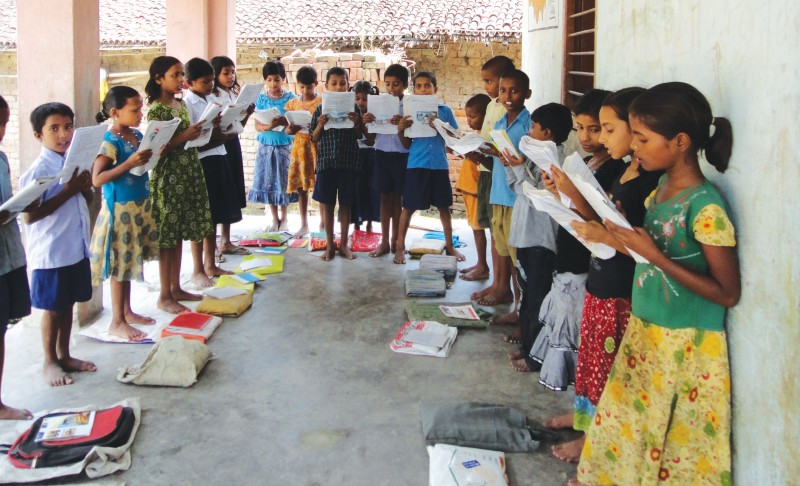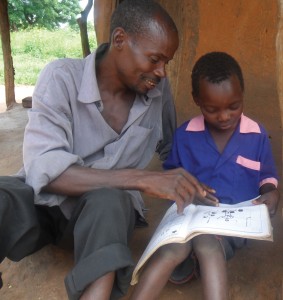EARLY GRADE READING:
Sticky Situations and Surefire SolutionsNovember 28, 2012
 USAID is working to produce meaningful, measurable improvement in student reading for the largest possible number of children. Many primary school children in low income countries cannot read at grade level, and many in the early grades cannot even read a single word. Low-income countries perform, on average, at the bottom 20 percent in the world. USAID’s implementing partners, including Creative, are committed to supporting instruction in native languages in early grades, improving teaching techniques and learning materials, conducting regular assessments in partner countries to measure reading skills, maximizing instruction time spent on basic skills in the classroom, especially reading, and promoting parental and community involvement in early grade reading.
USAID is working to produce meaningful, measurable improvement in student reading for the largest possible number of children. Many primary school children in low income countries cannot read at grade level, and many in the early grades cannot even read a single word. Low-income countries perform, on average, at the bottom 20 percent in the world. USAID’s implementing partners, including Creative, are committed to supporting instruction in native languages in early grades, improving teaching techniques and learning materials, conducting regular assessments in partner countries to measure reading skills, maximizing instruction time spent on basic skills in the classroom, especially reading, and promoting parental and community involvement in early grade reading.
Creative is pioneering efforts to quickly retrofit and scale up existing projects to support USAID’s goal of improving the reading skills of 100 million primary grade children by 2015. Recently, at the Global Partnership for Education International “Literacy Day,” Diane Prouty, PhD, Creative’s Senior Education Research Specialist, shared Creative’s insights and practical advice gained from projects in Nigeria, Tanzania, Yemen and Zambia for successfully navigating this new terrain.
In order to meet its ambitious goal, USAID is asking its implementing partners to refocus existing education projects on early grade reading. Frequently, there has not been the opportunity to conduct national reading assessments, policy dialogues, or experimental pilots which are typical precursors of new reading projects. Re-aligning an existing project is just part of the challenge in making the transition. If the host country Ministry of Education is not on board, the challenge can be daunting. Several questions immediately surface. How do you leverage government ownership to ensure realignment to best practices within the context of an on-going reform effort? What kind of information and approaches can be used when data about students’ reading performance is not available to promote and foster the dialogue and to leverage support for change? What are the necessary steps to implement this change?
 Answering these questions can be especially hard when there is no Early Grade Reading Assessment (EGRA) data or when key stakeholders challenge EGRA data. A good approach is to provide a window into the “reality” of how well children are learning to read by conducting classroom observations or rapid ASER type assessments on children in target grades. This not only provides data on student reading skills, but also presents opportunities for skeptics and “naysayers” to see and “test” for themselves what is happening in classrooms.
Answering these questions can be especially hard when there is no Early Grade Reading Assessment (EGRA) data or when key stakeholders challenge EGRA data. A good approach is to provide a window into the “reality” of how well children are learning to read by conducting classroom observations or rapid ASER type assessments on children in target grades. This not only provides data on student reading skills, but also presents opportunities for skeptics and “naysayers” to see and “test” for themselves what is happening in classrooms.
In many countries, there may be no dedicated or formal reading curriculum and/or adequate time in the daily school schedule to teach reading. A good approach is to provide decision makers with “learning by doing” experience. This can be done by conducting policy and/or curriculum mapping and gap analysis, comparing their existing curriculum with an exemplary curriculum, or hosting a reading research workshop. These hands-on approaches serve to engage key leaders, equipping them to make informed decisions about the direction they want reading to go in their country.
Normally, a pilot project provides the basis for refining and directing an EGRA intervention. When faced with the need to gear up wide scale implementation and to go from “zero to sixty words-per-minute” without the benefit of a pilot project, one workable solution is to build in a “quasi pilot.” This can be done by phasing in activities by grade, i.e. first “learning to read” in grades 1 & 2 and then “reading to learn” from grade 3 up. A complementary approach is to carry out action research in a subset of schools, which can provide rapid, real-time feedback into content, methods, and materials revision. These “quasi pilot” approaches provide a window to modify an intervention based on what is learned, emphasizing quick results in phonics and decoding.

Reading materials are an essential part of a reading program, but often existing materials are not geared to a reading curriculum or appropriate for the skill level of students. When counterparts tell you they already have reading materials, it is best to let them “do the math” to see for themselves whether the materials are in fact appropriately leveled. Work with them to carry out an analysis of the reading materials by counting syllables, words in a sentence, words on a page, time between reinforcement of words, font size, and color to determine if the materials “pass” the decodability and readability test. This can be reinforced by hosting workshops with potential authors to introduce concepts of leveled and decodable reading materials. These steps help underscore the need for a holistic approach that aligns development of instructional materials with the research-based reading approach.
If Ministry of Education officials are on a totally different page, you should look for a common interest to jumpstart a new reading component. Look for alignment points, like Information & Communications Technology or e-content, that can create an opening for reading. Another approach is to negotiate a short window of implementation that produces early results. Starting this conversation builds towards an opening to demonstrate the real value-added by the proposed reading-focused project modification.
You may encounter gaps in the ability of teachers in grades 1 and 2 to teach reading skills. You can seek to maximize your effort by conducting a classroom-based triage of teachers within 6-8 weeks of starting the intervention. Develop deployment criteria and incentives to help get the best and most appropriate teachers in grades 1 and 2. This will allow you to reduce support to those who understand the approach and those who are not receptive and to focus remedial support on those teachers who can most benefit. By doing so, you can prioritize your resources to ensure fidelity and quality of implementation.
Changing the focus of a project to support Early Grade Reading does not mean abandoning an institutional approach or walking away from working relationships. Although you need to keep in mind that you should not try to fit a square peg into a round hole, you can focus on the common institutional elements of the initial and realigned projects. After all, at core, most education programs focus on better learning and instruction. You will probably work with same offices just different content experts. For example, institutional capacity building will still be needed in curriculum development, assessment, and materials design. Ultimately, you cannot achieve sustainable change without engaging key stakeholders and adopting a systems approach that addresses policy, capacity, and budget issues that provide the enabling environment for reading improvement.
— Diane Prouty, Senior Education Research Specialist, with Karen Tietjen, Technical Director, Education for Development Division
